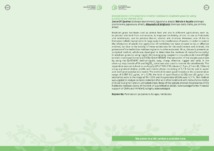Determination of metsulfuron-methyl residues in elephant grass by using (LC/ESI)-Q-ToF-MS/MS (813).
Determination of metsulfuron-methyl residues in elephant grass by using (LC/ESI)-Q-ToF-MS/MS (813).
Author(s): QUEIROZ, S. C. do N. de; ASSALIN, M. R.; BRIGHENTI, A. M.
Summary: Elephant grass has been used as animal feed and also in diff erent applications, such as, to protect arid land from soil erosion, to improve the fertility of soil, to use as fi rebreaks and windbreaks, and to produce bio-oil, alcohol and charcoal. However, one of the its limitation in fi eld implantation in large scale is the interference of weeds. In order to control the infestation of weeds the application of herbicides has been showed to be an eff ective method, but due to the toxicity of these substances for the environment and animals, the presence of the herbicides residues in plants must be evaluated. Thus, this work presents an analytical method, which was developed to determine the residues of metsulfuron-methyl in elephant grass by using Liquid chromatography coupled to a quadruplole time-of-fl ight tandem mass spectrometry (LC/ESI)- Q-ToF-MS/MS. The extraction of the analyte was made by using the QuEChERS method (quick, easy, cheap, eff ective, rugged and safe). In the clean-up step, besides PSA and MgSO4, florisil was also used to remove the interferents. The separation was carried out on an Acquity UPLC® BEH C18 column (1.7 ?m, 2.1mm ID, 100mm) using a gradient elution profi le and mobile phase consisting of 0.1 % formic acid in water and methanol (positive-ion mode). The method showed good linearity in the concentration range of 0.001?0.2 ?g/mL, (r2 ? 0.99); the limit of quantifi cation (LOQ) was 20 ?g/kg-1; the recoveries were in the range of 93?120% and the precision (RSD%) was 12.7 %. The method was applied to analyze samples collected after 45 d after treatment with metsulfuron-methyl (7.8 and 15.6 g ha-1) and an untreated check. None of the sample showed the presence of the herbicide residues above of the limit of quantifi cation (LOD). Acknowledgements: Financial support of CNPq and FAPEMIG is highly acknowledged.
Publication year: 2016
Types of publication: Abstract in annals or event proceedings
Unit: Embrapa Environment
Keywords: Forage, Forrageira, Herbicida, Herbicides, Pennisetum purpureum
Observation
Some of Embrapa's publications are published as ePub files. To read them, use or download one of the following free software options to your computer or mobile device. Android: Google Play Books; IOS: iBooks; Windows and Linux: Calibre.
Access other publications
Access the Agricultural Research Database (BDPA) to consult Embrapa's full library collection and records.
Visit Embrapa Bookstore to purchase books and other publications sold by Embrapa.

